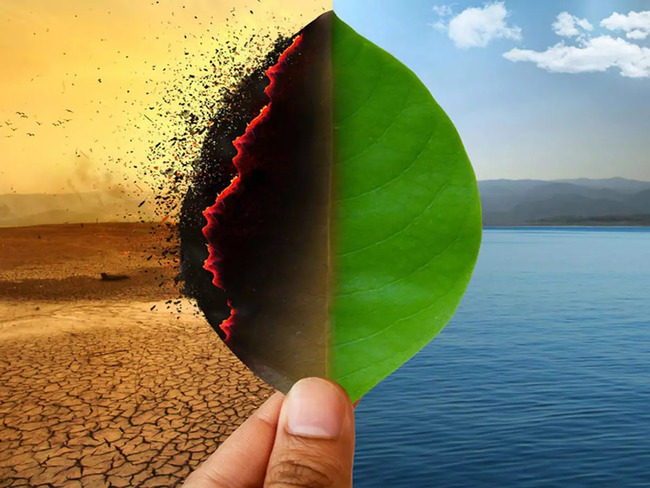Global climate rapid changes can be seen due to human activities that are contributing to extreme weather conditions. When fossil fuels are burnt for transportation, electricity, and heat, carbon dioxide greenhouse gas is released into the atmosphere. This carbon dioxide traps solar radiation. There has been a huge increase in methane, carbon dioxide, and other greenhouse gas emissions over the past century has caused the temperature on Earth to rise. That increase in global temperature is fueling climate disaster. It will get worse if action is not taken. Experts warn that humans are running out of time to reduce pollution and to avoid climate disasters.
Effects of climate change –
Wildfires –
In the western US, wildfires have always been a natural part of life. Day by day, the region is growing hotter and drier, wildfires are increasing in size, ferocity, and speed. For meteorological turmoil in recent years, California has become ground zero. Across the state record, dry and hot climates can be seen. The seasonal high winds caused destructive wildfires to grow and spread at an unprecedented rate.
The California fire burned more than 4 million acres in 2020. 2020 was the biggest fire season in state history. In the last three years, the five largest fires have occurred in California. Colorado, Washington, Oregon have also seen explosive fires that made thousands evacuate, destroyed homes, claimed lives, businesses were affected.
Climate gets hotter –
NASA and NOAA have revealed that Earth is getting hotter. Since the late 19th century, the Earth has warmed more than 2degrees Fahrenheit. Those trends are continuing and even be accelerating. As global temperature rises, the number of areas impacted by extreme heat is also growing. For example, Austin has seen the number of days with temperatures above 100°F increase by one month. According to the Union of Concerned Scientists, throughout 2100, scientists predict more frequent and intended heatwaves and hotter temperatures. Extreme increases the demand for air conditioning and fueling carbon pollution. It also poses a severe health threat.
The Paris Agreement was signed in 2016, an international treaty made within the UN Framework Convention on Climate Change. The agreement’s goal is to limit global warming to 1.5 degrees Celsius. If the global temperature is not limited, then extreme climate conditions will prevail.
Drought increases –
Shortfalls cause the increase in drought in precipitation, earlier snowmelt, a shift from light and moderate rains towards short, heavy precipitation events, and increased evaporation from soil and vegetation due to higher atmospheric temperatures. The intensity and duration of drought are increased because the increase in heating leads to greater moisture evaporation from land. Individual droughts have been linked to climate change.
Droughts in many parts of the world, including the US, have become more severe and long-lasting because of climate change. West America is currently amid a megadrought. Much of the region is facing extreme or exceptional drought conditions. Rising temperature has also led to earlier melting of snowpack in the area. Early snowmelt, along with increased precipitation to fall as rain rather than snow has contributed to the drought in the region.
Increase in precipitation –
Total annual precipitation on average has increased over land areas in the US and worldwide. At an average rate of 0.10 inches, global precipitation has increased per decade since 1901. It can have wide-ranging effects on human well-being and ecosystems. The amount of surface water and groundwater available for industries, irrigation, drinking can be affected by snowfall, rainfall, and snowmelt timing. River flooding is also influenced by it and determines what plants and animals survive in a particular place. A wide range of natural processes can be disturbed by changes in precipitation.
Overall precipitation increases because more evaporation occurs as the average temperature on the Earth’s surface rises. Therefore in many areas warming climate will increase precipitation. Some parts of the US have experienced more significant increases in precipitation than others, and few parts have seen a decrease in precipitation.
Hurricanes are becoming more intended –
An increase in destructive hurricanes is putting people and infrastructure at risk. The social, economic, and physical scars left behind by significant hurricanes are devastating for coastal regions. Hurricanes are a natural part of the climate system; recent research suggests that the intensity of hurricanes has increased in recent years. Shortly, the number of hurricanes may not increase, but the intensity will increase for sure that carries higher wind speeds and more precipitation due to global warming.
As global temperatures rise, hurricanes are becoming more powerful because these storm systems draw their energy from warm ocean water. In August 2020, one of the most powerful storms hit the US Gulf Coast. The storm caused damage to infrastructure and suspected chemical fires among the region’s petrochemical plants. In the future, humans can expect to see more hurricanes.
Rise in the sea level –
Rising sea level creates stress on coastal ecosystems. As the sea level increases, the saltwater contaminates freshwater aquifers, many of which sustain municipal and agricultural water supplies and natural ecosystems. Ocean waters are warming and expanding because of Earth warming. Warmer temperatures are causing ice and glaciers to melt, which is adding to the world’s ocean. The decline in the amount of liquid water on land, lakes and reservoirs, rivers, soil moisture is also causing the sea levels to rise. Due to groundwater pumping, there is a shift of liquid water from land to ocean.
In the last 150 years, the average global sea level has increased by eight inches. Currently, the Atlantic coast of the US and the Gulf of Mexico is experiencing some of the highest sea-level rises in the world, which combined with record rainfall, lots of flooding can be seen in these areas.
Winter storms have increased –
Climate change is causing an increase in the intensity and snowfall of winter storms. More moisture is found in the atmosphere now, which causes heavier than normal precipitation, including heavier snowfall. In part of norther US heavy snowfall and snowstorm, frequency have increased. In the Northern Hemisphere, overall snow cover has decreased because of an increase in average global temperature. Many research has shown that decades of warming and rapid heating of the Arctic are contributing to changes in mid-latitude climate and weather and the occurrence of extreme events.
Conclusion –
One must take immediate action to reduce the climate change effect. Fossil fuels should be kept in the ground, and pollution should be cleaned up as much as possible. Countries need to set ambitious climate goals and remove barriers to clean energy. Governments should also focus on protecting climate forests, promoting climate-smart agriculture, and stopping the petrochemical buildout.


